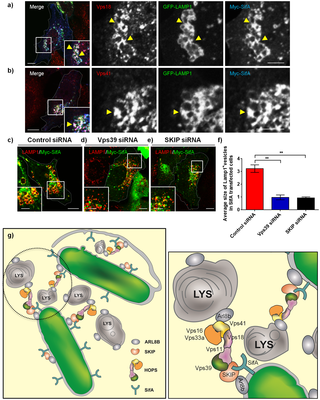PLoS Pathogens ( IF 5.5 ) Pub Date : 2017-10-30 , DOI: 10.1371/journal.ppat.1006700 Aastha Sindhwani 1 , Subhash B Arya 2 , Harmeet Kaur 1 , Divya Jagga 1 , Amit Tuli 2 , Mahak Sharma 1

|
Salmonella enterica serovar typhimurium extensively remodels the host late endocytic compartments to establish its vacuolar niche within the host cells conducive for its replication, also known as the Salmonella-containing vacuole (SCV). By maintaining a prolonged interaction with late endosomes and lysosomes of the host cells in the form of interconnected network of tubules (Salmonella-induced filaments or SIFs), Salmonella gains access to both membrane and fluid-phase cargo from these compartments. This is essential for maintaining SCV membrane integrity and for bacterial intravacuolar nutrition. Here, we have identified the multisubunit lysosomal tethering factor—HOPS (HOmotypic fusion and Protein Sorting) complex as a crucial host factor facilitating delivery of late endosomal and lysosomal content to SCVs, providing membrane for SIF formation, and nutrients for intravacuolar bacterial replication. Accordingly, depletion of HOPS subunits significantly reduced the bacterial load in non-phagocytic and phagocytic cells as well as in a mouse model of Salmonella infection. We found that Salmonella effector SifA in complex with its binding partner; SKIP, interacts with HOPS subunit Vps39 and mediates recruitment of this tethering factor to SCV compartments. The lysosomal small GTPase Arl8b that binds to, and promotes membrane localization of Vps41 (and other HOPS subunits) was also required for HOPS recruitment to SCVs and SIFs. Our findings suggest that Salmonella recruits the host late endosomal and lysosomal membrane fusion machinery to its vacuolar niche for access to host membrane and nutrients, ensuring its intracellular survival and replication.
中文翻译:

沙门氏菌利用宿主内溶酶体束缚因子 HOPS 复合物促进其液泡内复制。
肠沙门氏菌鼠伤寒血清型广泛重塑宿主晚期内吞区室,以在宿主细胞内建立有利于其复制的液泡生态位,也称为含沙门氏菌的液泡 (SCV)。通过以相互连接的小管网络(沙门氏菌诱导的细丝或 SIF)的形式与宿主细胞的晚期内体和溶酶体保持长时间的相互作用,沙门氏菌可以从这些隔室中获取膜和液相货物。这对于维持 SCV 膜的完整性和细菌液泡内营养至关重要。在这里,我们确定了多亚基溶酶体束缚因子——HOPS(HO motypic fusion andProtein Sorting )复合物作为关键宿主因子促进晚期内体和溶酶体内容物向 SCV 的传递,为 SIF 形成提供膜,并为液泡内细菌复制提供营养。因此,HOPS 亚基的消耗显着降低了非吞噬细胞和吞噬细胞以及沙门氏菌感染小鼠模型中的细菌负荷。我们发现沙门氏菌效应器 SifA 与其结合伙伴复合;SKIP,与 HOPS 亚基 Vps39 相互作用并介导这种束缚因子向 SCV 隔室的募集。结合并促进 Vps41(和其他 HOPS 亚基)的膜定位的溶酶体小 GTPase Arl8b 也是向 SCV 和 SIF 募集 HOPS 所必需的。我们的研究结果表明,沙门氏菌将宿主晚期内体和溶酶体膜融合机制招募到其液泡生态位,以获取宿主膜和营养物质,确保其细胞内存活和复制。










































 京公网安备 11010802027423号
京公网安备 11010802027423号